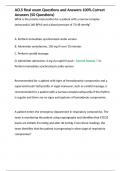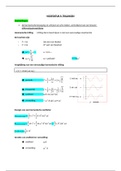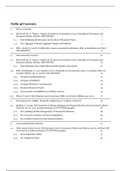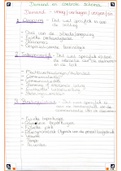UNIT 1: Sources of error
Accuracy (how close measurements are to their true value) VS Precision (how close measurements are to each other)
Random errors (natural, unavoidable, affect precision, e.g. human reaction error - minimized by taking the average of multiple measurements; repeating trials avg
random errors thereby reducing uncertainty).
Systematic errors (reproducible inaccuracies that consistently occur in the same direction, affect accuracy, e.g. faulty data collection, frictional forces, heat loss -
minimized by calibrating measurement instruments, refining experimental procedures; they’re not related to repetition of trials as they’re constant/fixed/always
present)
- heat loss presents systematic error ✔ 2 taking the difference cancels/eliminates the effect of these losses
𝑛𝑒𝑤 𝑣𝑎𝑙𝑢𝑒 − 𝑜𝑟𝑖𝑔𝑖𝑛𝑎𝑙 𝑣𝑎𝑙𝑢𝑒
𝑃𝑒𝑟𝑐𝑒𝑛𝑡𝑎𝑔𝑒 𝑖𝑛𝑐𝑟𝑒𝑎𝑠𝑒 = 𝑜𝑟𝑖𝑔𝑖𝑛𝑎𝑙 𝑣𝑎𝑙𝑢𝑒
× 100
𝐸𝑠𝑡𝑖𝑚𝑎𝑡𝑒𝑑 𝑁𝑢𝑚𝑏𝑒𝑟 – 𝐴𝑐𝑡𝑢𝑎𝑙 𝑁𝑢𝑚𝑏𝑒𝑟
𝑃𝑒𝑟𝑐𝑒𝑛𝑡𝑎𝑔𝑒 𝐸𝑟𝑟𝑜𝑟 = 𝐴𝑐𝑡𝑢𝑎𝑙 𝑛𝑢𝑚𝑏𝑒𝑟
× 100
Deviation:
Σ 𝑚𝑒𝑎𝑠𝑢𝑟𝑒𝑚𝑒𝑛𝑡𝑠
- 𝑚𝑒𝑎𝑛 = # 𝑡𝑟𝑖𝑎𝑙𝑠
𝑚𝑎𝑥 𝑣𝑎𝑙𝑢𝑒 𝑜𝑓 𝑖𝑛𝑡𝑒𝑟𝑐𝑒𝑝𝑡 − 𝑚𝑖𝑛 𝑣𝑎𝑙𝑢𝑒 𝑜𝑓 𝑖𝑛𝑡𝑒𝑟𝑐𝑒𝑝𝑡
- 𝑎𝑏𝑠𝑜𝑙𝑢𝑡𝑒 𝑑𝑒𝑣𝑖𝑎𝑡𝑖𝑜𝑛 = 𝑚𝑒𝑎𝑠𝑢𝑟𝑒𝑚𝑒𝑛𝑡 − 𝑚𝑒𝑎𝑛 or 𝑎𝑏𝑠𝑜𝑙𝑢𝑡𝑒 𝑢𝑛𝑐𝑒𝑟𝑡𝑎𝑖𝑛𝑡𝑦 = 2
Σ 𝑎𝑏𝑠𝑜𝑙𝑢𝑡𝑒 𝑑𝑒𝑣𝑖𝑎𝑡𝑖𝑜𝑛𝑠
- 𝑚𝑒𝑎𝑛 𝑎𝑏𝑠𝑜𝑙𝑢𝑡𝑒 𝑑𝑒𝑣𝑖𝑎𝑡𝑖𝑜𝑛 = # 𝑡𝑟𝑖𝑎𝑙𝑠
𝑚𝑒𝑎𝑛 𝑎𝑏𝑠𝑜𝑙𝑢𝑡𝑒 𝑑𝑒𝑣𝑖𝑎𝑡𝑖𝑜𝑛
- 𝑟𝑒𝑙𝑎𝑡𝑖𝑣𝑒 𝑑𝑒𝑣𝑖𝑎𝑡𝑖𝑜𝑛 = 𝑚𝑒𝑎𝑛 𝑚𝑒𝑎𝑠𝑢𝑟𝑒𝑚𝑒𝑛𝑡 × 100
Line of best fit:
- With data given, use calculator (CALC → SET → REG → X → ax+b)
- Passes as closely as possible to all of the data points and passes through all uncertainty bars. This doesn’t necessarily mean having the same # points above/below line.
- If the relationship is expected to be directly proportional (passing through the origin) but the data points and the line of best fit do not intercept the origin, this may indicate a systematic error.
- A direct proportionality between two variables is supported by a straight line of best fit through the origin.
Uncertainties: when calculating the total uncertainty in a value derived from multiple measurements, each with its uncertainty:
𝑎𝑏𝑠𝑜𝑙𝑢𝑡𝑒 𝑢𝑛𝑐𝑒𝑟𝑡𝑎𝑖𝑛𝑡𝑦
- Add percentage uncertainties if measurements are multiplied/divided: 𝑝𝑒𝑟𝑐𝑒𝑛𝑡𝑎𝑔𝑒 𝑢𝑛𝑐𝑒𝑟𝑡𝑎𝑖𝑛𝑡𝑦 = 𝑚𝑒𝑎𝑠𝑢𝑟𝑒𝑑 𝑣𝑎𝑙𝑢𝑒
× 100
𝑎𝑏 ∆𝑦 ∆𝑎 ∆𝑎
- If 𝑦 = 𝑐
but b and c have negligible uncertainty, then 𝑦
= 𝑎
thus ∆𝑦 = 𝑦 𝑎
.
- Add absolute uncertainties if measurements are added/substracted
- First round uncertainties to one s.f, then round measurement to the same decimal places as the rounded uncertainty.
- When provided with a raw measurement and its percentage uncertainty, to find the experimental value, first calculate the absolute uncertainty and round it to one significant figure. Then, express the
measurement to the same decimal precision as the rounded uncertainty to obtain the adjusted experimental value that reflects the uncertainty's precision.
- When asked to comment on your result with uncertainty and an expected value, calculate the range of values by adding and subtracting the absolute uncertainty from your measurement. The check
if the expected value falls within the range.
Variables:
- Control variables
- Dependent variable: what is observed/measured. The experiment is repeated for different values of the dependent variable to confirm the relationship with the independent variable.
- Independent variable: what is changed.
Scalars (magnitude + unit value)
Vectors (magnitude + unit + direction/angle)
,UNIT 2: Mechanics
Avg. vs Instantaneous: compare avg. gradient with tangent at one point. If the two are parallel, the avg. speed is equivalent to the instantaneous speed at that point.
Ex.
Uniform acceleration (only!) → SUVAT equations (s = displacement, u = initial velocity, v = final velocity, a = acceleration, t = time interval)
- Given the vertical distance traveled (assuming no 𝑢, or air resistance), the time to land can be calculated. With this time (given constant 𝑣𝑥) one can find the horizontal distance traveled.
- Displacement on an inclined plane:
Projectile motion: solve the vertical and horizontal components separately
- For an object dropped from a height h (assuming u=0 and no air resistance):
2
- 𝑠 = ℎ − ½ 𝑔𝑡
1 2
- 𝑚𝑔∆ℎ = 2
𝑚∆𝑣 + 𝐸𝑑𝑖𝑠𝑝𝑒𝑟𝑠𝑒𝑑.
- For an object launched vertically from the ground (assuming no air resistance):
2
- 𝑠 = 𝑢𝑡 − ½ 𝑔𝑡
- 𝑣 = 𝑢 − 𝑔𝑡
𝑇 𝑇 1 2 1
- At max. height v=0, thus 𝑢 = 𝑔 2
→𝑠 = 𝑔 2
𝑡− 2
𝑔𝑡 = 2
𝑔𝑡(𝑇 − 𝑡)
1 2 1 2
- The sign before the acceleration term, 2
𝑔𝑡 or 2
𝑎𝑡 , depends on the direction of acceleration relative to the initial displacement or velocity.
,Air Resistance:
−2
- Ideal conditions = freefall (𝑔 = 9. 81 𝑚𝑠 ) causes ONLY vertical acceleration, horizontal velocity is constant.
- With air resistance: vertical and horizontal acceleration, opposing direction of motion.
- The speed of an object dropped from a tall building increases at a decreasing rate.
- > mass (e.g look image empty ball) > resistance > time to reach terminal velocity,
- Terminal velocity: W = F(air resistance)
Forces
Newton’s laws: 1) Law of Inertia: objects stay at rest, or in constant motion unless acted upon by a force, 2) Law of Acceleration: F = ma 3) Action-Reaction: Every force generates an equally strong and
opposite reaction force (of the same type) that acts on different objects.
- Net force: To find the potential net force acting on an object, add the forces together when they are fully aligned (i.e., in the same direction) and when they are directly opposite to each other (i.e., in
parallel but opposite directions). This provides the range within which the resultant force lies.
- Reaction forces: occur only between objects in contact, e.g. there’s no reaction force to F in the diagram below.
- Pseudo forces: arise due to the acceleration of the frame of reference itself and not as a result of physical interaction between objects. They oppose the direction of acceleration of the object.
- Inertial frame: a frame of reference either at rest or at a constant velocity, in which Newton’s laws are valid (i.e. zero force = zero acceleration), and there are no pseudo forces.
- Non-inertial frame: a frame of reference either at uniform linear acceleration or rotating at a constant speed, in which Newton’s laws are not invalid, (i.e. zero force ≠ zero acceleration)
- If the observer is inside: there are pseudo-forces (e.g. if the person is standing inside a moving truck, for everything inside to be still there must be forces in equilibrium.
- If the observer is outside: there aren’t pseudo forces. (e.g. For someone outside the truck who can see inside, the contents do not appear stationary but seem to be
accelerating at the same rate as the truck)
- Free body diagrams only show “real” forces, which don’t include pseudo forces. Hence either an inertial frame or outside a non-inertial frame.
, Examples
Person in the elevator. When the lift accelerates upward, the Retropropulsion. As the probe descends towards the asteroid, it String and Pulley- If the string is assumed to be massless and the
person inside feels “heavier” due to a pseudo force acting down has a downward momentum due to its velocity and mass. The pulley frictionless, the acceleration will be the same in magnitude
on him. This force + its weight is balanced by an upward pushing rocket engine produces an upward thrust, which is a force that for both masses, but in opposite directions.
acts in the opposite direction to the probe's momentum. Since this
normal force on him. The greater this normal (contact) force the
force is greater than the gravitational force, the net force on the
heavier the person feels. The opposite happens when the lift probe is upward. This will cause the probe to decelerate. When
accelerates downwards. this upward force is applied over some time, it changes the
probe's downward momentum, reducing its velocity toward the
asteroid. This ∆𝑝 is equal to the impulse provided by the rocket
engine. If the engine continues to exert this net force, the
downward velocity will decrease to zero. If the thrust continues
beyond this point, the probe will gain upward momentum, causing
it to move away from the asteroid.
Friction
𝑓 = µ𝑁 (N ⊥ friction and Ff is NOT a reaction to Wx)
- Static friction, 𝑓 = µ𝑠𝑅: the force that must be overcome to initiate movement. It represents the maximum force of friction before the object begins to move. Until this point, friction increases
proportionally as the opposing force increases.
- Dynamic friction, 𝑓 = µ𝑑𝑅: the force of friction that acts when the object is in motion. This force remains constant, regardless of any additional force applied to the object, and is usually less than
static friction.
- The work done by a frictional force (f) to bring a mass (m) to rest from an initial velocity (u) over a horizontal distance (d) is 𝑊 = 𝑓𝑑. Since the work done is equal to the change in kinetic energy
2 2 2
𝑊 = ∆𝐸𝑘, we can write 𝑊 =
1
2 ( )
𝑚 𝑣 − 𝑢 , where v is the final velocity (zero in this case as the mass comes to rest). Thus, −
1
2
𝑚𝑢 = 𝑓𝑑. The negative sign accounts for the work done against the
motion by friction.
Accuracy (how close measurements are to their true value) VS Precision (how close measurements are to each other)
Random errors (natural, unavoidable, affect precision, e.g. human reaction error - minimized by taking the average of multiple measurements; repeating trials avg
random errors thereby reducing uncertainty).
Systematic errors (reproducible inaccuracies that consistently occur in the same direction, affect accuracy, e.g. faulty data collection, frictional forces, heat loss -
minimized by calibrating measurement instruments, refining experimental procedures; they’re not related to repetition of trials as they’re constant/fixed/always
present)
- heat loss presents systematic error ✔ 2 taking the difference cancels/eliminates the effect of these losses
𝑛𝑒𝑤 𝑣𝑎𝑙𝑢𝑒 − 𝑜𝑟𝑖𝑔𝑖𝑛𝑎𝑙 𝑣𝑎𝑙𝑢𝑒
𝑃𝑒𝑟𝑐𝑒𝑛𝑡𝑎𝑔𝑒 𝑖𝑛𝑐𝑟𝑒𝑎𝑠𝑒 = 𝑜𝑟𝑖𝑔𝑖𝑛𝑎𝑙 𝑣𝑎𝑙𝑢𝑒
× 100
𝐸𝑠𝑡𝑖𝑚𝑎𝑡𝑒𝑑 𝑁𝑢𝑚𝑏𝑒𝑟 – 𝐴𝑐𝑡𝑢𝑎𝑙 𝑁𝑢𝑚𝑏𝑒𝑟
𝑃𝑒𝑟𝑐𝑒𝑛𝑡𝑎𝑔𝑒 𝐸𝑟𝑟𝑜𝑟 = 𝐴𝑐𝑡𝑢𝑎𝑙 𝑛𝑢𝑚𝑏𝑒𝑟
× 100
Deviation:
Σ 𝑚𝑒𝑎𝑠𝑢𝑟𝑒𝑚𝑒𝑛𝑡𝑠
- 𝑚𝑒𝑎𝑛 = # 𝑡𝑟𝑖𝑎𝑙𝑠
𝑚𝑎𝑥 𝑣𝑎𝑙𝑢𝑒 𝑜𝑓 𝑖𝑛𝑡𝑒𝑟𝑐𝑒𝑝𝑡 − 𝑚𝑖𝑛 𝑣𝑎𝑙𝑢𝑒 𝑜𝑓 𝑖𝑛𝑡𝑒𝑟𝑐𝑒𝑝𝑡
- 𝑎𝑏𝑠𝑜𝑙𝑢𝑡𝑒 𝑑𝑒𝑣𝑖𝑎𝑡𝑖𝑜𝑛 = 𝑚𝑒𝑎𝑠𝑢𝑟𝑒𝑚𝑒𝑛𝑡 − 𝑚𝑒𝑎𝑛 or 𝑎𝑏𝑠𝑜𝑙𝑢𝑡𝑒 𝑢𝑛𝑐𝑒𝑟𝑡𝑎𝑖𝑛𝑡𝑦 = 2
Σ 𝑎𝑏𝑠𝑜𝑙𝑢𝑡𝑒 𝑑𝑒𝑣𝑖𝑎𝑡𝑖𝑜𝑛𝑠
- 𝑚𝑒𝑎𝑛 𝑎𝑏𝑠𝑜𝑙𝑢𝑡𝑒 𝑑𝑒𝑣𝑖𝑎𝑡𝑖𝑜𝑛 = # 𝑡𝑟𝑖𝑎𝑙𝑠
𝑚𝑒𝑎𝑛 𝑎𝑏𝑠𝑜𝑙𝑢𝑡𝑒 𝑑𝑒𝑣𝑖𝑎𝑡𝑖𝑜𝑛
- 𝑟𝑒𝑙𝑎𝑡𝑖𝑣𝑒 𝑑𝑒𝑣𝑖𝑎𝑡𝑖𝑜𝑛 = 𝑚𝑒𝑎𝑛 𝑚𝑒𝑎𝑠𝑢𝑟𝑒𝑚𝑒𝑛𝑡 × 100
Line of best fit:
- With data given, use calculator (CALC → SET → REG → X → ax+b)
- Passes as closely as possible to all of the data points and passes through all uncertainty bars. This doesn’t necessarily mean having the same # points above/below line.
- If the relationship is expected to be directly proportional (passing through the origin) but the data points and the line of best fit do not intercept the origin, this may indicate a systematic error.
- A direct proportionality between two variables is supported by a straight line of best fit through the origin.
Uncertainties: when calculating the total uncertainty in a value derived from multiple measurements, each with its uncertainty:
𝑎𝑏𝑠𝑜𝑙𝑢𝑡𝑒 𝑢𝑛𝑐𝑒𝑟𝑡𝑎𝑖𝑛𝑡𝑦
- Add percentage uncertainties if measurements are multiplied/divided: 𝑝𝑒𝑟𝑐𝑒𝑛𝑡𝑎𝑔𝑒 𝑢𝑛𝑐𝑒𝑟𝑡𝑎𝑖𝑛𝑡𝑦 = 𝑚𝑒𝑎𝑠𝑢𝑟𝑒𝑑 𝑣𝑎𝑙𝑢𝑒
× 100
𝑎𝑏 ∆𝑦 ∆𝑎 ∆𝑎
- If 𝑦 = 𝑐
but b and c have negligible uncertainty, then 𝑦
= 𝑎
thus ∆𝑦 = 𝑦 𝑎
.
- Add absolute uncertainties if measurements are added/substracted
- First round uncertainties to one s.f, then round measurement to the same decimal places as the rounded uncertainty.
- When provided with a raw measurement and its percentage uncertainty, to find the experimental value, first calculate the absolute uncertainty and round it to one significant figure. Then, express the
measurement to the same decimal precision as the rounded uncertainty to obtain the adjusted experimental value that reflects the uncertainty's precision.
- When asked to comment on your result with uncertainty and an expected value, calculate the range of values by adding and subtracting the absolute uncertainty from your measurement. The check
if the expected value falls within the range.
Variables:
- Control variables
- Dependent variable: what is observed/measured. The experiment is repeated for different values of the dependent variable to confirm the relationship with the independent variable.
- Independent variable: what is changed.
Scalars (magnitude + unit value)
Vectors (magnitude + unit + direction/angle)
,UNIT 2: Mechanics
Avg. vs Instantaneous: compare avg. gradient with tangent at one point. If the two are parallel, the avg. speed is equivalent to the instantaneous speed at that point.
Ex.
Uniform acceleration (only!) → SUVAT equations (s = displacement, u = initial velocity, v = final velocity, a = acceleration, t = time interval)
- Given the vertical distance traveled (assuming no 𝑢, or air resistance), the time to land can be calculated. With this time (given constant 𝑣𝑥) one can find the horizontal distance traveled.
- Displacement on an inclined plane:
Projectile motion: solve the vertical and horizontal components separately
- For an object dropped from a height h (assuming u=0 and no air resistance):
2
- 𝑠 = ℎ − ½ 𝑔𝑡
1 2
- 𝑚𝑔∆ℎ = 2
𝑚∆𝑣 + 𝐸𝑑𝑖𝑠𝑝𝑒𝑟𝑠𝑒𝑑.
- For an object launched vertically from the ground (assuming no air resistance):
2
- 𝑠 = 𝑢𝑡 − ½ 𝑔𝑡
- 𝑣 = 𝑢 − 𝑔𝑡
𝑇 𝑇 1 2 1
- At max. height v=0, thus 𝑢 = 𝑔 2
→𝑠 = 𝑔 2
𝑡− 2
𝑔𝑡 = 2
𝑔𝑡(𝑇 − 𝑡)
1 2 1 2
- The sign before the acceleration term, 2
𝑔𝑡 or 2
𝑎𝑡 , depends on the direction of acceleration relative to the initial displacement or velocity.
,Air Resistance:
−2
- Ideal conditions = freefall (𝑔 = 9. 81 𝑚𝑠 ) causes ONLY vertical acceleration, horizontal velocity is constant.
- With air resistance: vertical and horizontal acceleration, opposing direction of motion.
- The speed of an object dropped from a tall building increases at a decreasing rate.
- > mass (e.g look image empty ball) > resistance > time to reach terminal velocity,
- Terminal velocity: W = F(air resistance)
Forces
Newton’s laws: 1) Law of Inertia: objects stay at rest, or in constant motion unless acted upon by a force, 2) Law of Acceleration: F = ma 3) Action-Reaction: Every force generates an equally strong and
opposite reaction force (of the same type) that acts on different objects.
- Net force: To find the potential net force acting on an object, add the forces together when they are fully aligned (i.e., in the same direction) and when they are directly opposite to each other (i.e., in
parallel but opposite directions). This provides the range within which the resultant force lies.
- Reaction forces: occur only between objects in contact, e.g. there’s no reaction force to F in the diagram below.
- Pseudo forces: arise due to the acceleration of the frame of reference itself and not as a result of physical interaction between objects. They oppose the direction of acceleration of the object.
- Inertial frame: a frame of reference either at rest or at a constant velocity, in which Newton’s laws are valid (i.e. zero force = zero acceleration), and there are no pseudo forces.
- Non-inertial frame: a frame of reference either at uniform linear acceleration or rotating at a constant speed, in which Newton’s laws are not invalid, (i.e. zero force ≠ zero acceleration)
- If the observer is inside: there are pseudo-forces (e.g. if the person is standing inside a moving truck, for everything inside to be still there must be forces in equilibrium.
- If the observer is outside: there aren’t pseudo forces. (e.g. For someone outside the truck who can see inside, the contents do not appear stationary but seem to be
accelerating at the same rate as the truck)
- Free body diagrams only show “real” forces, which don’t include pseudo forces. Hence either an inertial frame or outside a non-inertial frame.
, Examples
Person in the elevator. When the lift accelerates upward, the Retropropulsion. As the probe descends towards the asteroid, it String and Pulley- If the string is assumed to be massless and the
person inside feels “heavier” due to a pseudo force acting down has a downward momentum due to its velocity and mass. The pulley frictionless, the acceleration will be the same in magnitude
on him. This force + its weight is balanced by an upward pushing rocket engine produces an upward thrust, which is a force that for both masses, but in opposite directions.
acts in the opposite direction to the probe's momentum. Since this
normal force on him. The greater this normal (contact) force the
force is greater than the gravitational force, the net force on the
heavier the person feels. The opposite happens when the lift probe is upward. This will cause the probe to decelerate. When
accelerates downwards. this upward force is applied over some time, it changes the
probe's downward momentum, reducing its velocity toward the
asteroid. This ∆𝑝 is equal to the impulse provided by the rocket
engine. If the engine continues to exert this net force, the
downward velocity will decrease to zero. If the thrust continues
beyond this point, the probe will gain upward momentum, causing
it to move away from the asteroid.
Friction
𝑓 = µ𝑁 (N ⊥ friction and Ff is NOT a reaction to Wx)
- Static friction, 𝑓 = µ𝑠𝑅: the force that must be overcome to initiate movement. It represents the maximum force of friction before the object begins to move. Until this point, friction increases
proportionally as the opposing force increases.
- Dynamic friction, 𝑓 = µ𝑑𝑅: the force of friction that acts when the object is in motion. This force remains constant, regardless of any additional force applied to the object, and is usually less than
static friction.
- The work done by a frictional force (f) to bring a mass (m) to rest from an initial velocity (u) over a horizontal distance (d) is 𝑊 = 𝑓𝑑. Since the work done is equal to the change in kinetic energy
2 2 2
𝑊 = ∆𝐸𝑘, we can write 𝑊 =
1
2 ( )
𝑚 𝑣 − 𝑢 , where v is the final velocity (zero in this case as the mass comes to rest). Thus, −
1
2
𝑚𝑢 = 𝑓𝑑. The negative sign accounts for the work done against the
motion by friction.










